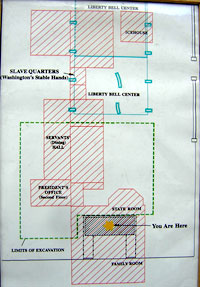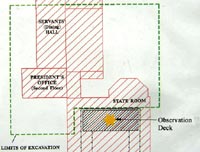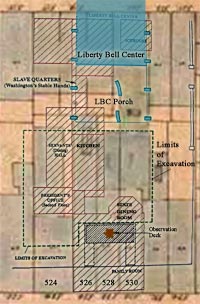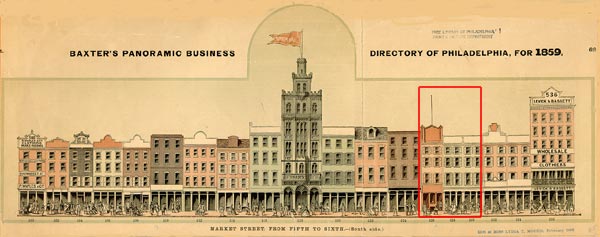Archaeology at the President's House
What Has Been Found?
Resources
- Archaeology Team for the President's House Dig (photo)
- Bow Window Forerunner of the Oval Office
- 19th Century Pipe Discovered with the image of an African man
- URS Archaeology heads the President's House archaeology team
- Press Release, March 21, 2007
- U.S. Dept of the Interior Briefing Statement Archaeology at the President's House Site, Jan. 12, 2006
Photo Galleries
- Pictures of artifacts
- October 2007: Grass on the Dig
- July 31, 2007: Archaeology Closing Ceremony.
- July 20, 2007: Ten more days
- Week of July 4, 2007: No wells and no privies from the President's House era! Where are they? The number of visitors this week was huge. Kudos to the archaeologists who spread out to answer everyone's questions.
- June 18, 2007: President's Office plus root cellar.
- June 5, 2007: 3 wells and a 19th century privy — no 18th century privy?
- May 31, 2007: More pit features
- May 24, 2007: Pit features
- May 15, 2007: More bow window; more "mystery wall"
- May 8, 2007: Bow window foundation discovered and servant's passageway
- May 1, 2007: Kitchen foundation found
- April 26, 2007: A "large cent" from 1833 is found plus a "mystery wall"!
- April 17, 2007: Removing the top fill
Archaeology was completed on July 31, 2007.
Kichen
The archaeologists found foundations of the kitchen. No documentary evidence indicated that the kitchen, originally built as a one-story building, had a basement, so it was an unexpected find. It was here that Hercules, an enslaved African and renowned chef, worked and prepared the food for the President's household and for dignitaries. Hercules escaped into the darkness from this house, and there is no historic record of what became of him.
Bow Window
Archaeologists uncovered curved foundation fragments of the Bow Window that Washington added to the State Dining Room to create a ceremonial space in which the public would meet the President. The shape of this bow is echoed in the oval rooms at the center of the White House, and in the Oval Office itself. There was no expectation of finding a 10-foot deep foundation for this addition by Washington, so the find came as a surprise.
Underground Passage
Additionally, they found the foundation for the underground passage that connected the kitchen and the main house. This is thought to have been used as a service area, mostly by the enslaved and indentured workers at the house. Much like the back passages at hotels, it kept the help "hidden," or out of sight. It shares a 14-foot wall with the President's private office.
Artifacts
A couple thousand artifacts were excavated from the site, although at first glance there does not seem to be anything identifiably from the presidential period. The archaeology lab will closely examine the artifacts over the coming months. It is run with trained professional and some volunteers.
In a joint press release, the Park Service and the Mayor of Philadelphia noted, "More than a quarter million visitors have stood at the public viewing platform to witness this extraordinary place, to learn from the archaeologists, and to interact with each other on important topics such as race relations in the United States. The reaction to the site has served as a signal that the President's House site has the potential to become a major national icon in the heart of the City."
Maps
Also see: Hexamer and Locher Map 1858-62








